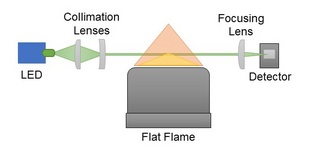Marc Baumgardner, PhD
LED-Spectroscopy
Lasers have been used for many
years as a means of combustion diagnostics because they are non-intrusive and
offer high accuracy and precision measurements. By far, two of the most common
and well understood techniques are laser-induced absorbance and fluorescence
wherein the wavelength of the laser is tuned to a specific optical transition
of a target species (typically with a precision of much less than a nano-meter).
Such techniques offer a means of speciation and temperature measurements within
a variety of combusting systems such as flames and engines. However, these
tools are not without their disadvantages, the most obvious being cost. A
typical laser diagnostic setup using a tunable diode laser can easily cost half
a million dollars (likely more) and take up a significant portion of laboratory space. Furthermore,
with the advent of increased desire to have on-board diagnostics of combusting
systems in both industry and academic settings, the above drawbacks prohibit
the use of lasers in many applications.

Fig 1. Schematic of the experimental setup depicting an absorption measurement.
